TEA UTANSILS
茶の湯の道具類
Lamps - Those used in the Tea-room are of the simplest kind, consisting omly of a stand, either of wood or bamboo, to ehich is attached a horizontal projection to hold the wick saucer of rough pottery. This saucer has a small bamboo ring to hold the wick threads in place. Vegetable oil is used. They are called Tankei and are of various styles.
灯 ー 茶室の中で使われる灯はとてもシンプルです。スタンドのみで、木もしくは竹でできていて素焼きのお皿を置くための水平の突起物が取り付けられています。そのお皿には灯芯の紐をひっかけるための竹の輪がついています。油は植物性のものを使います。タンケイと言って色々な形があります。
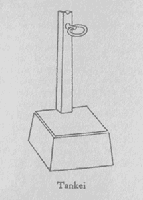
That called Yahazu or Arrow-Notch was a fevourite of So-on, the wife of Rikyu. The Andon is the same type of light but enclosed in papered lantarn of square or oblong or tapering shape.
矢はずと呼ばれる物は利休の妻SOーONのお気に入りでした。行灯と言う道具も同様に明かり取りですが、灯を紙で囲ってあって四角、長方形、円形等のものがあります。
* The round Andon or Night-light is the invention of Kobori Enshu, who first made it in this shape, and also suspended the light stand in the middle instead of having it on the floor of the lamp as formerly.
* 行灯は小堀遠州の発明でこの形を作りました。また、床から中ほどの所へ明かりをつり下げたりしてフォーマルな感じにたりもしました。
It may be for outside or indoor use. The dimentsions of these lamps should be in propotion to the size of the room.
家屋の内外で使い、寸法は部屋の大きさによって決められています。
The Furo or furnace is made in various shape. There is the Nara Fur, The Bronze Furo, the Cheek-plate Fure, which is like the cheek-plate of a helmet, the Devil Furo and the Jujube Furo. The Furo has three feet and accoding to the shape of these is called Teat-foot or Spindle-foot, and there are fenestrotions both in front and behind.
風炉にもさまざまあり、奈良風炉、銅風炉、チーク板風炉これはヘルメットの様な形、鬼風炉、じゅじゅべ風炉などです。そして、三種類の形、Teat−FootやスピンドルFoot前後に窓のついたものがあります。
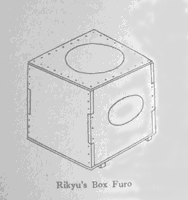
The first Furo came from T`ang. It was called Devil-face Teat-foot. It was destroyed in the Onin wars. (Chado Zentei.) Rikyu made a Furo of wood for Hideyoshi when campaigning at Odawara. He thought it rather suitable for Cha-no-yu in the field. It was of ceder, lacquered and shaped like box, so called Odawara Furo or Box Furo.
風炉の初めは唐から来ました。鬼面風炉と呼ばれるもので応仁の乱のころです。利休は木製の風炉を作りました、それは秀吉の小田原攻めの時です。野で茶をたてられるように、杉に漆を施し箱の様にしました。それを小田原風炉と呼びます。
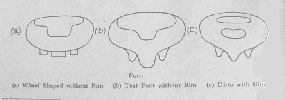
Konoe Iehiro had one made from one of the "Giboshi" or bosses of a pillar of the long bridge of Seta that had been thrown away when the bridge was rebuilt. It had a very fine patina, for it was quite old, and the shape was interesting. This was in 1772.
近衛家煕と言う人が橋の柱の擬宝(ギボシ)を風炉に見立利用しました。橋の立替の時に取り外したものを再利用でもってきて、青銅で青錆が出ていてとても古く、形も素晴らしいものでした。1772年の事です。
The Furo is used only in the summer, though in a place where no hearth is cut in the floor it is permissible to use it for winter Tea. The months recknoed as summer are May to Ocrober inclusive, while from November to April the hearth is used. It is said that the Furo should be used as soon as a red bud is seen on the Kaname or Chinese hawthorn tree, and the change made to the hearth when the Yuzu or citron begins to yellow.
風炉は夏期に使われ、部屋の中に炉が切っていない場合のみ、その他の季節の使用が認められています。具体的な月としては夏季と言うのは五月から十月、冬季とは十一月から翌四月までを言います。自然に目を向けることが大切で、春、カナメの木の赤い芽が出たらそれまでの炉から風炉に替えて、寒くなってユズの実が黄色く色づいたら炉に替えるのです。
But if the Furo is used in winter or, so may sometimes happen, the hearth in summer, the proper use of the season should always be preserved: in the case of the Furo it should be treated as though it were a hearth if used in winter, so that the correct distinctions my be preserved.
ただし、風炉を冬に炉を夏に使うケースもおきることがあります。風炉や炉はその時の為に常にお手入れをしておかなければなりません、それが茶の湯の本質でもあります。
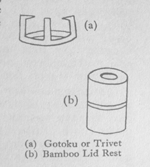
The Gotoku (Five Virtues) or Trivet used to support the kettle on the hearth or Furo was in use from the time of Sho-o. A board is used as a stand for the Furo. The large one measures 1 ft. 4 in. square and the small one half this. The small one is used with a large size Furo, and a large one with the small size for the sake of asymmetry.
風炉の釜をのせるのにつかう三脚台のことを五徳といいます。これは紹鴎のときに始まりました。風炉の下に一枚の板を置きます。大きいサイズは1フィート4インチ半(30.48+4*2.54+=41cm)の正方形で小さい方はその半分です。小さい板は大きな風炉に使い大きな板は小さなものに使うという不均衡を表現しています。
Kettle were of various shapes, some round and others square, some square ones having a round mouth and vice versa. Bag shape and Fuji shape are also common.
釜はさまざまな形があります。丸いものから四角いものまで、四角いものは丸い口です。袋や富士の形もまた一般的です。
* Echigo-no-Kami Moroyasu was a worthless fellow. He confiscated the endowment of the light that had burned before Buddha in the Tennoji for seven hundred years, so that it went out, and made the Kurin or bronze pinnacle of the pagoda into a Tea-kettle, so that it became the fashion among the samurai, and few pagoda were left intact.
古典軍記の太平記に茶釜の話があります。700年続いたお寺の天王寺が焼失し、侍たちがそこにあった九輪塔をこぞって茶釜に模したらしい。それを越後守モリヤスという人が没収した。
They were named from some peculiarity or association.
釜にはそれぞれ名前がついていて、それは独特で連想的です。
Thus Mozuya, Amida-do, Daruma-do are from places, Shiribari, Koshi-manji and Kikusui are from their peculiar shape or the design embossed on them, while Raisei(Thunder-voice) and Ubaguchi(Hag's mouth) are comic designations.
次のような名、万代(もずや)、阿弥陀堂(あみだどう)、達磨堂(だるまどう)は場所を根拠に名付けられました。尻張(しりはり)、甑口(こしきぐち、)菊水(きくすい)等はその独特の形や浮き出し模様から、雷鳴(らいめい)姥口(うばぐち)は絵画からその名をとっています。
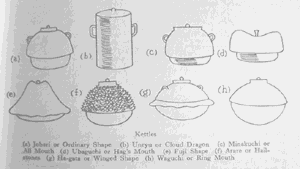
The Kettle-stand (Kmashiki) is made of Mino paper or bamboo. The King of Luchu sent a bamboo flower vase to Sen Sotan and he cut off part of it and used it as a Kettle-stand.
釜を置く釜敷は美濃紙や竹で作られています。李朝の王様が千宗旦へ竹の花瓶を送り、彼がそれを釜敷に使ったと言う話もあります。
The kettle-hanger (Jizai) was adapted from the farmhouse kichin like the hearth. It is very suitable in small room of one -and-half or two-and-a half mats.
自在は釜を吊るす道具で農家の囲炉裏道具から来ました。一畳半とか二畳半の小さな茶室にとても似合います。
Tea-jars (Cha-tsubo) for leaf tea. The Sen family possesses three of theas that are well-known, two from Luzon and one of Shigaraki ware. The first two were brought to Japan in Hideyoshi's time. One is called Renge-o because it has the character O (king) on it and a lotus (renge), the other Seiko (Pure Perfume) because it is thus inscribed. Some of the best of there jars are said to have been dredged up out of the Western Lake at Hangchow and are no doubt Sung.
お茶の葉を入れておくものを茶壷と言います。千家にはとても有名な壷は三個あり、二個はルソンからの物でもう一つは信楽の物です。ルソンの二個は秀吉の時代に日本に渡って来ました。名を蓮華王と呼び蓮華の上に王の文字がるもの、もう一つは清香と呼びもじどうりその文字が彫られています。これらの壷はHangchowの西湖で彫り起こされた物で宋時代で間違いないでしょう。
Mizusashi - The Mizusashi or cold water vessel is made in many shapes, usually of porcelain, celadon or pottery, or it may be lacquer. The wooden variety seems to have been invented by Rikyu. The origin of the square well-bucket variety is thus described.
水指は水を入れておく器物で様々な形があります。通常は磁器や青磁、土物の素材で、漆の物もあります。木製の物もあり、それは利休によって考案されました。釣瓶水指(つるべみずさし)の逸話があります。
Rikyu was giving a Cha-no-yu on a very hot day in summer and as he drew the water from the well it seemed so cold and fresh in the bucket that the happy thought came into his mind to unshackle the bucket from the rope and take it into the Tea-room and use it as a Mizusashi specialy made in this shape for use in summer, and as the square shape went particularly well with the round Furo it has became one of the conventional styles and is known as Rikyu's well-bucket.
利休は夏の暑い日に茶の湯を催そうとした時の事です。涼しさや新鮮な雰囲気をと思い、井戸から水を汲みあげて撒き水をしていました。彼はその水を汲んでいた釣瓶(つるべ)を縄からはずして茶室へもってはいり、水指として見立てることを思いつきました。取り合わせてみると、その四角い形が横の風炉と絶妙で、その後、この釣瓶水指(つるべみずさし)は利休の代表的な形として慣例的に使われる様になったのです。
But it is also sometime used in the winter as well and the sanction for this is the experience of Sen Sotan who once went to drow water on a morning that was so cold that it froze immediately, before he could pour it into the mizusashi, for he had put down the backet for a moment beside the well, and so he took it into the Tea-room and broke the ice with the ladle and used it instead of the Mizusashi. So in memory of this occasion its use is justified even with the square hearth.
時々冬にも使われるようになりました、それは千宗旦によってです。彼は冬の寒い朝、水を撒くとすぐ凍ってしまうのを利用して、井戸から釣瓶で汲んだ水を水指に入れる前に井戸のそばにすこし置いておきます。それから茶室の中へ持ち込み、中で凍ってしまった氷を柄杓で砕き、それを趣向として水指として使うのです。炉の時期の取りあわせとして、やはり、正統化されました。
INTRODUCTION-1 TITLE CONTENTS